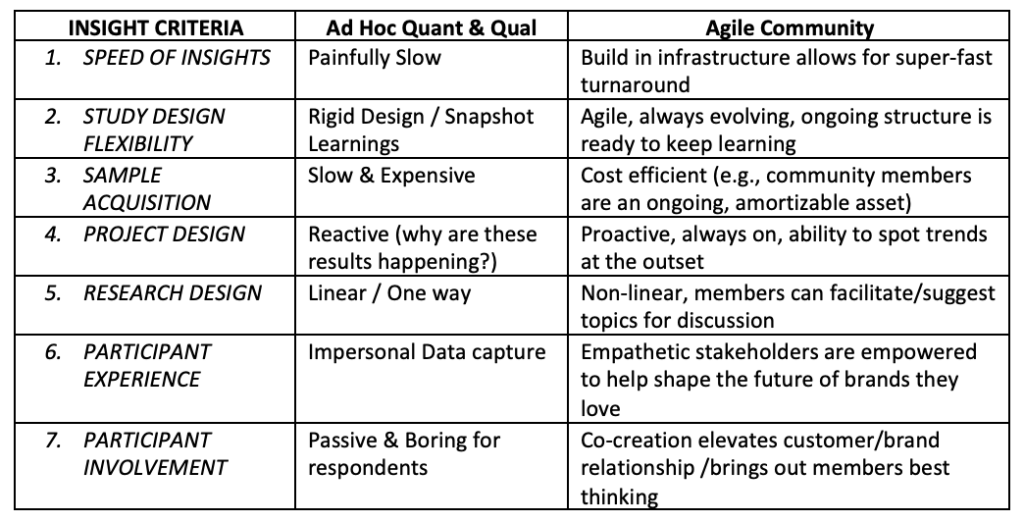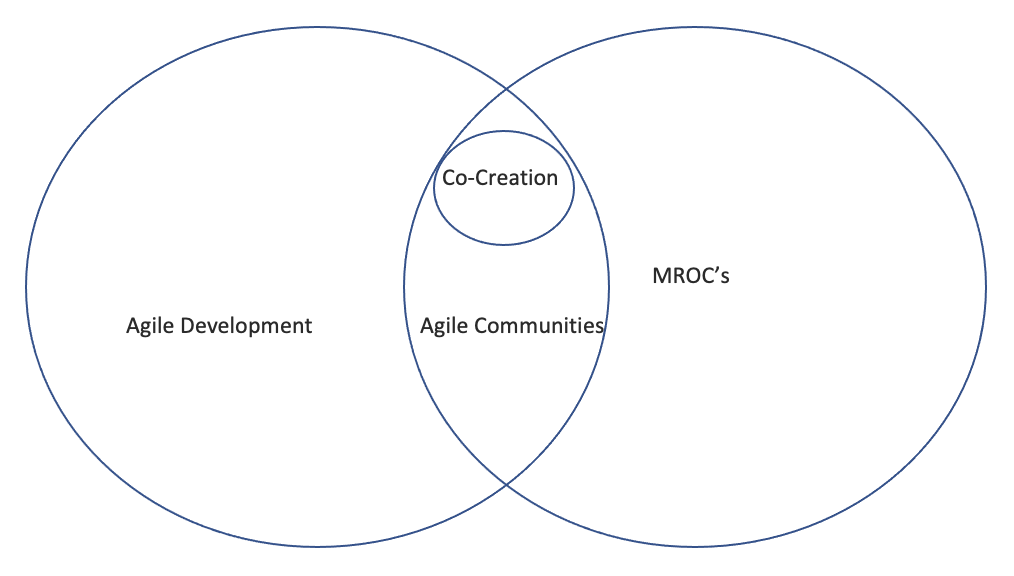
Agile Online Communities are becoming the empathetic cornerstone of a new collaborative relationship with customers.
Established in almost every major organization, Insights Communities have become nearly ubiquitous. Their proliferation, driven by cost and timing efficiencies allow Insights Departments to offer a significant ROI over comparable ad hoc spend.
Owing to the versatility of insights communities, they are a major player in both Quant & Qual data collection. According to the January 2021 GRIT Report, communities are the 3rd most cited form of qual & quant* data collection:
- QUAL / 71% using communities either regularly or occasionally
- QUANT / 75% using regularly or occasionally
Still, for most corporations, Insights Communities are seen as a convenient, cost effective tactical tool. Perfectly suitable for quick indicators, but not reliable for major strategic initiatives.
That landscape, however, is changing. While no one disputes the cost efficiencies of insights communities, one can question how much of a community atmosphere they actually foster. The need to move beyond a research transactional based relationship to one based on an ongoing empathetic relationship is leading to the rise of Agile Communities.
Customer Empathy as a Form of Competitive Advantage
Empathy for ones customers, while altruistic is also a key competitive advantage. The need to achieve customer closeness has opened up the doors for agile research. Empathy has become the buzzword of the early 20’s. Corporations are aware they are stuck in their own echo chamber and to truly understand people’s needs you need to understand their pain points. And you do not get there without an “interactive empathy tool”.
Any organization that can monetize customer-closeness will be able to bring products & services to market faster with higher success rates. Again, customer closeness cannot simply be corporate focused. Based on principles of social reciprocity, an agile community elevates the customer from replaceable widget to valued stakeholder. The currency for the customer is largely intrinsic, with reciprocity born from making a difference for the brands of which they are passionate.
Once you begin to view customers as advisors, you also need to elevate their role to that of brand ambassadors. These agents of customers co-creation are best utilized via agile, iterative, non-linear learnings.
And market research insights do not exist in a bubble. The concept of Design Thinking is entering the lexicon of the C-Suite. Speed, agility, and research needs to fit into design thinking speed. As insights professionals, the warning is clear; adapt or be bypassed.
The chart below delineates the advantages an Agile Community offers over traditional ad hoc.

Agile Research is a derivative of the agile development process. For definition, I’ll use Jeffrey Henning’s “beg, borrowed and shoplifted” version from the Green Book blog:
“Agile research is a type of market research in which the requirements and solutions evolve through collaboration between researcher and sponsor. It is not phased research but is iteratively open-ended, refining the research until all key questions are answered“
– Jeffrey Henning
The fact that agile research is phased makes it especially well placed within the contexts of an Insights Community where members are engaged for long periods of time. An insight community thus becomes the perfect home for agile research. It also allows members to participate in multiple phases. Without the community, the researcher needs to constantly find new sample for each phase and also loses the contextual understanding of how the new product/service is evolving.
Co-Creation is one potential application of an agile community. Consistent with the sharing economy with expected social reciprocity between customers and their favorite brands (i.e., a worthy value proposition for both member & company), customer co- creation allows customers skin in the game. For the lack of a universal definition, I will offer my own:
“Co-Creation describes an agile, structured environment for infusing customer creativity at the onset of the product/service design process. The process is inherently iterative to allow for collaboration among all contributing stakeholders.“
Co-Creation requires the agile research process, as the infusion of customer creativity needs to be parceled on an iterative basis. It is a subset of the agile research universe. On the other hand, agile research does not necessarily imply a co-creation scenario. It can be done via traditional surveys or online qual techniques. It applies to any research objective that is best served via iterative reevaluation.
Agile research and customer co-creation share the idea that customer inspiration is best portioned asynchronously so that the proposed offering/solution (e.g., concept design, product prototype, etc.) can systematically evolve.
A key requirement of a successful agile process is continual commitment and time from internal stakeholders. The process gets grounded if the team cannot continue to assess customer feedback and move towards the next iterative approach (e.g., a revised concept or prototype).
The following diagram shows the relative position of agile research and customer co-creation in the product development universe. Co-Creation, as a subset of Agile Research belongs to both the Agile Development & Market Research circles but is governed by the rules of Agile Development that require multiple waves of collaborative interaction.

What makes Agile Communities and Customer Co-Creation so exciting is that they are born out of the Internet era. The idea of fast iterative development infused by customer inspiration belongs to Agile Development. The fact that they are powered by structured customer insights allows them to overlap and also belong to the world of Market Research.
And while Agile Communities and Customer Co-Creation currently represent only a fraction of current MROC revenue, they are clearly aligned with 21st century product development principles of customer empathy, collaboration, and iterative, rapid development.
ROI Based on Business Impact, Not Cost Savings
Which brings me to my final point, the ROI that can be attributed to an Agile Community vastly exceeds that of a traditional insights community.
Typically, ROI has been measured by the savings over comparable ad hoc research.
But insights & innovation functions are being tasked to impact the bottom line. Agile Communities are perfectly situated to serve as incubation hubs. They could easily become the new epicenter for R&D testing as well as the go to source of insights for innovation.
As the launching pad for new product/service introductions, the ROI of an Agile Community can be measured by the number of new products/services it helps bring to market. In short, a far more strategic ROI measuring criteria.
Want to learn more about what KLC has to offer?
Lets Chat